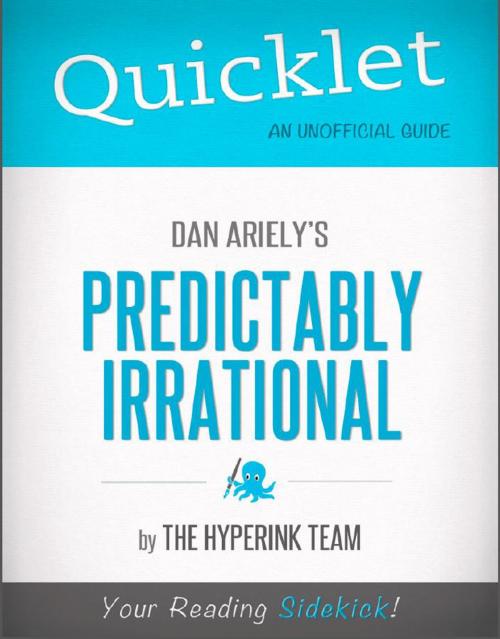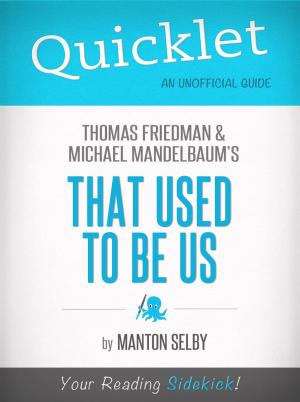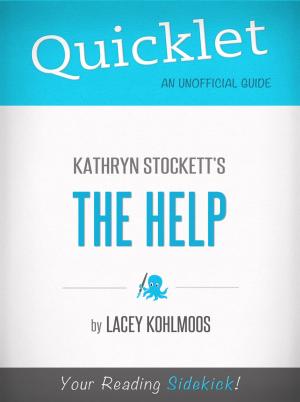Quicklet on Dan Ariely's Predictably Irrational (CliffNotes-like Book Summary)
Nonfiction, Reference & Language, Study Aids, Book Notes, Fiction & Literature, Literary Theory & Criticism| Author: | The Hyperink Team | ISBN: | 9781614646235 |
| Publisher: | Hyperink | Publication: | July 30, 2012 |
| Imprint: | Hyperink | Language: | English |
| Author: | The Hyperink Team |
| ISBN: | 9781614646235 |
| Publisher: | Hyperink |
| Publication: | July 30, 2012 |
| Imprint: | Hyperink |
| Language: | English |
ABOUT THE BOOK
“If I were to distill one main lesson from the research described in this book, it is that we are pawns in a game whose forces we largely fail to comprehend.”
Dan Ariely’s book Predictably Irrational introduces the public to a new economic discipline that punches lethal holes in the science of classical economics, the field of behavioral economics. As David Berreby writes in his New York Times review of Predictably Irrational, “this sly and lucid book is not about your grandfather’s dismal science.”
Predictably Irrational hit shelves in 2008, a time when readers were ready to denounce any and all established notions about modern finance and monetary policy. When the book came out, the world economy was spiraling at full speed into a recession; the bottom of which hardly anyone could foresee. Indeed we would not reach that bottom for a long while, and the crippling global economic downturn of the late 2000’s would be dubbed The Great Recession.
Months after Predictably Irrational published, former Federal Reserve Chairman Alan Greenspan testified before the US Congress. “Those of us who have looked to the self-interest of lending institutions to protect shareholders’ equity, myself included,” he said, “are in a state of shocked disbelief” (New York Times, Greenspan Concedes Error on Regulation). As Chairman of the Federal Reserve, Greenspan oversaw a period of prosperity in the United States (1987-2006) characterized by low borrowing rates and deregulation (Encyclopedia Britannica, “Alan Greenspan”). His admission of the failure of “self-interest” to produce a healthy economy was the equivalent of the Pope proclaiming his skepticism of the New Testament.
Things looked bad for the old models of economics thought. But what, exactly, were the alternatives?
Predictably Irrational, and behavioral economics more largely, is able to step into this vacuum and offer a powerful observation. Traditional economists operate on one key assumption, that participants in a market act rationally to achieve ends motivated by their own self-interest. Behavioral economists declare that assumption to be untrue based on common sense, experience, and—most importantly—empirical data.
EXCERPT FROM THE BOOK
p>“According to the assumptions of standard economics, all human decisions are rational and informed, motivated by an accurate concept of the worth of all goods and services and the amount of happiness (utility) all decisions are likely to produce.”
When defecting from a foundational scientific discipline, it is not enough to say, “People are not rational, so there you have it.” You must also answer, specifically: How so? To what extent? Why? To those ends, Ariely and his colleagues around the world devised a plethora of experiments meant to catch our instances of irrationality and allow for, of all things, a rational analysis of our dumb calls.
These experiments took place over many years, but many of them are so entertaining to read of that it can seem they were designed to be featured in a best selling book. Yet the bemusing quality of Ariely’s results stem from the fact that, for all of its seeming capriciousness, our irrationality fits into recognizable patterns. All humans have the same wetware in our skulls. We all live in societies that, while perhaps culturally different, are social communities more akin to each other than, say, a termite colony.
We can determine, through Ariely’s surprisingly potent and consistent results, that humans have a few certain ways in which we are irrational:We seek patterns. Upon encountering something unfamiliar, our brain seeks to make sense of it by comparison to our prior experiences.
ABOUT THE BOOK
“If I were to distill one main lesson from the research described in this book, it is that we are pawns in a game whose forces we largely fail to comprehend.”
Dan Ariely’s book Predictably Irrational introduces the public to a new economic discipline that punches lethal holes in the science of classical economics, the field of behavioral economics. As David Berreby writes in his New York Times review of Predictably Irrational, “this sly and lucid book is not about your grandfather’s dismal science.”
Predictably Irrational hit shelves in 2008, a time when readers were ready to denounce any and all established notions about modern finance and monetary policy. When the book came out, the world economy was spiraling at full speed into a recession; the bottom of which hardly anyone could foresee. Indeed we would not reach that bottom for a long while, and the crippling global economic downturn of the late 2000’s would be dubbed The Great Recession.
Months after Predictably Irrational published, former Federal Reserve Chairman Alan Greenspan testified before the US Congress. “Those of us who have looked to the self-interest of lending institutions to protect shareholders’ equity, myself included,” he said, “are in a state of shocked disbelief” (New York Times, Greenspan Concedes Error on Regulation). As Chairman of the Federal Reserve, Greenspan oversaw a period of prosperity in the United States (1987-2006) characterized by low borrowing rates and deregulation (Encyclopedia Britannica, “Alan Greenspan”). His admission of the failure of “self-interest” to produce a healthy economy was the equivalent of the Pope proclaiming his skepticism of the New Testament.
Things looked bad for the old models of economics thought. But what, exactly, were the alternatives?
Predictably Irrational, and behavioral economics more largely, is able to step into this vacuum and offer a powerful observation. Traditional economists operate on one key assumption, that participants in a market act rationally to achieve ends motivated by their own self-interest. Behavioral economists declare that assumption to be untrue based on common sense, experience, and—most importantly—empirical data.
EXCERPT FROM THE BOOK
p>“According to the assumptions of standard economics, all human decisions are rational and informed, motivated by an accurate concept of the worth of all goods and services and the amount of happiness (utility) all decisions are likely to produce.”
When defecting from a foundational scientific discipline, it is not enough to say, “People are not rational, so there you have it.” You must also answer, specifically: How so? To what extent? Why? To those ends, Ariely and his colleagues around the world devised a plethora of experiments meant to catch our instances of irrationality and allow for, of all things, a rational analysis of our dumb calls.
These experiments took place over many years, but many of them are so entertaining to read of that it can seem they were designed to be featured in a best selling book. Yet the bemusing quality of Ariely’s results stem from the fact that, for all of its seeming capriciousness, our irrationality fits into recognizable patterns. All humans have the same wetware in our skulls. We all live in societies that, while perhaps culturally different, are social communities more akin to each other than, say, a termite colony.
We can determine, through Ariely’s surprisingly potent and consistent results, that humans have a few certain ways in which we are irrational:We seek patterns. Upon encountering something unfamiliar, our brain seeks to make sense of it by comparison to our prior experiences.















